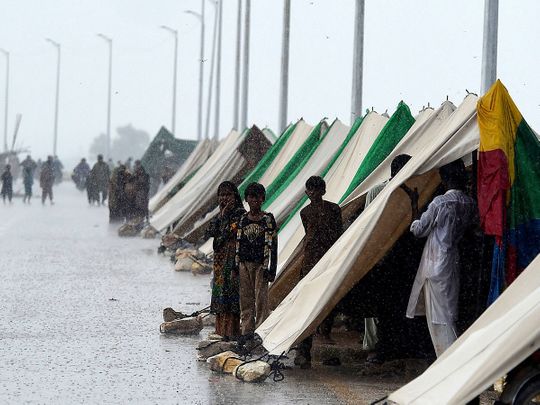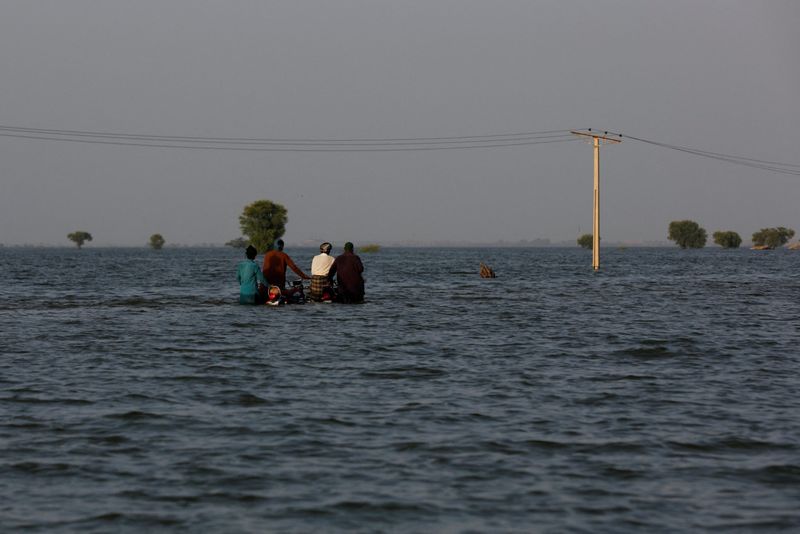
The record flooding that hit Pakistan in mid-June and continues today, as we speak, to impact the lives of its harried and beaten survivors, was of such epic proportions that it beggars belief.
Imagine this: The flooding has submerged one third (a whole one third!) of the country underwater, displacing 33 million people, inundating hundreds of villages, overflowing riverbanks and bridges transforming what had once been rolling fields and farmlands into lakes and killing more than 1,600 people, nearly half of them children.
Reportedly, it may take six months to a year for the floodwaters to completely recede and for the land to fully dry out.
That we all know by now. What we did not know till the news broke on Saturday was that the World Health Organisation (WHO) has raised the alarm about what the group called a “second disaster” from waterborne diseases, where many of the displaced, now living in tents and makeshift camps, face the clear and present danger of contracting infections such dengue fever, malaria and deadly strands of diarrhoea.

The floods were caused, as soon became obvious, by heavier-than-usual monsoon rain, but — and here’s the rub — these rains, as scientists asserted, were caused by greenhouse gas emissions, which often results in the likelihood of extreme downpours — making the monsoon season more destructive — in countries located in South Asia, which happen to be home to a quarter of the globe’s population.
Look, the link between global warming and weather disasters has already been mapped out, over and over again, with great confidence and specificity, by climate scientists. The catastrophic flooding in Pakistan was but the deadliest in recent manifestations of this phenomenon in the Northern hemisphere.
For consider, this year alone, the relentless droughts that hit the Horn of Africa, Mexico and China; the flash floods in West and Central Africa, Iran and several US inland states; and, lest we forget, the searing heatwaves that earlier this summer struck Japan, the western United States and Europe, including Britain, a country where you would have least expected to encounter something called a heatwave.
One thing is plain: The more heat-trapping, human-caused gases get pumped into the atmosphere the more extreme, the more frequent and the more deadly weather conditions we are likely to have.

Punished beyond the call of its guilt
And one other thing even plainer is this: Pakistan, not unlike other developing countries, is being punished beyond the call of its guilt for its contribution to adverse climate change, given the fact that, with 2.6 per cent of the world’s population, it is responsible for less than 1 per cent of carbon emissions, whereas, say, the United States, with about 4 per cent of that population, emits a staggering 14 per cent.
Yet, the former is made to pay a heavier price in monumental suffering than the latter. Yes, it’s true, there’s no justice in the world.
Pakistan has contended with varied natural disasters in recent times, including an earthquake in 2005 that killed nearly 90,00 people and severe flooding in 2010 that left millions homeless, but this summer’s unspeakable catastrophe, caused by climate change in a country least responsible for climate change, is beyond belief.
And watching the apocalyptic images that catastrophe left on the lives of so many, so very, very many, Pakistanis, most of them impoverished folks — and watching is the operative word here, for reading wouldn’t cut it, not by a stretch — has been gut-wrenching for those of us moved, in this case virtually to tears, by such irremediable human destitution.
To disabuse readers of the notion that this column is given to hyperbole, I will quote what UN General Secretary Antonio Guterres said in recent days. “I have seen many human disasters in the world, but I’ve never seen [one] on this scale”, he said, evincing whatever emotion a diplomat allows himself to evince in public. “I simply have no words to describe what I have seen today”.
Ever since the dawn of history, the menace that floods posed to human beings in their struggle against the elements — more so than other natural disasters, such as droughts, pandemics, earthquakes, famines and the like — has been central to our universal archetype.
We find it in the mythologies of hope and in the holy texts of civilisations that go far back and are as far apart as Ancient Egypt and Ancient China, where in the latter the 4,000-year-old myth known as the Great Flood of Gun-Yu had underlined Chinese culture for mill millennia. And the word remains central to this day as metaphor in our semantic fashions of expression (“Readers flooded the editor of Gulf News with complaints about this God-awful columnist”).
Save for the 1931 floods caused by a dyke breach, that followed heavy snowmelt, torrential rains and severe storms, in a landlocked region of eastern China by Lake Gaoyou, that unimaginably left close to 4 million people dead, few floods in modern history compare to the one that Pakistan has endured since mid-June, whose consequences the country is likely to continue enduring for a long time to come.
Let us pay Pakistan tribute by recognising how heavy is the burden it carries on the road to rebuilding the shattered lives of its millions of citizens.
— Fawaz Turki is a journalist, lecturer and author based in Washington. He is the author of The Disinherited: Journal of a Palestinian Exile.









